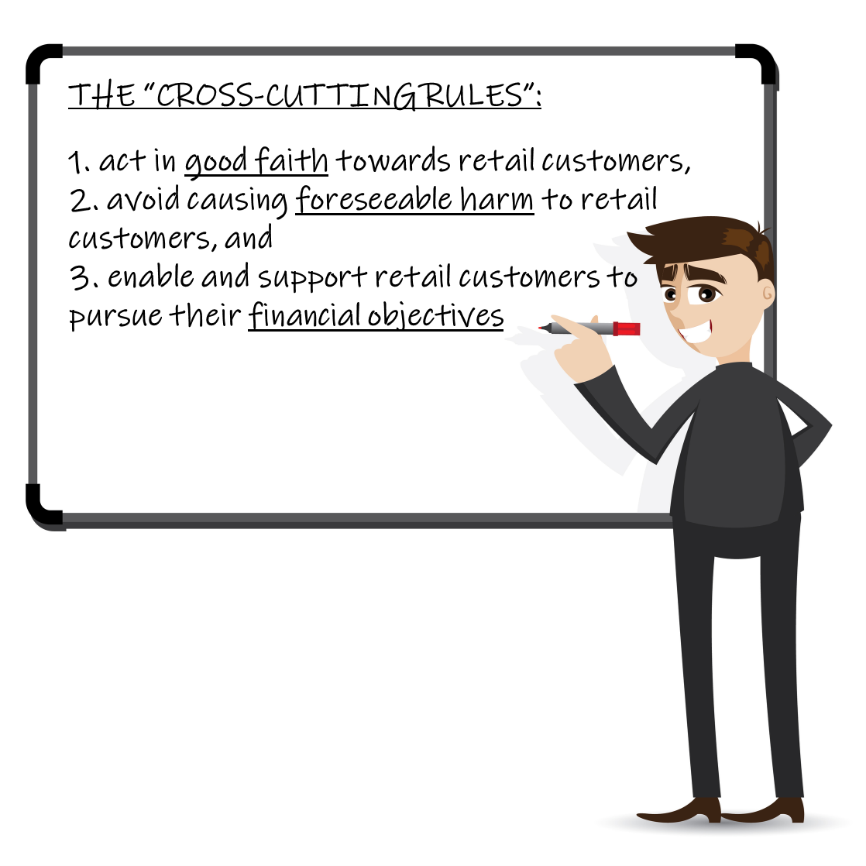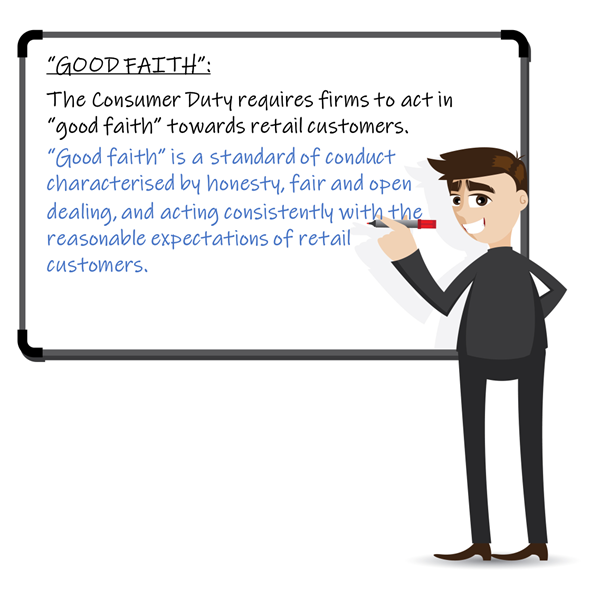The purpose of the cross-cutting rules is to provide guidance on the new Principle 12. The cross-cutting rules set out how firms should act (proactively and reactively) to deliver good outcomes for customers. As with the rest of the Consumer Duty, the cross-cutting rule can apply both at a target market level and an individual customer level, depending on the situation. The specific application of the rules in any given situation will typically depend on whether or not the firm is interacting with an individual retail customer or providing a bespoke service.
The cross-cutting rules require firms to:
- act in good faith towards retail customers,
- avoid causing foreseeable harm to retail customers, and
- enable and support retail customers to pursue their financial objectives.
The cross-cutting rules also inform (and are supported by) the four outcomes, which set out more detailed rules in key areas of the firm-customer relationship. More about those another day.
The cross-cutting rules apply at all stages of the customer journey and during the whole lifecycle of a product. Firms will therefore need to keep products under regular review and consider the impact of any changes they make to those products.

The Consumer Duty and the concept of “good faith”
The Consumer Duty’s cross-cutting rules require that firms act in “good faith” towards retail customers (both groups of customers and individuals) at all stages of the customer journey and during the whole lifecycle of a product or service. This begs the question: “what does it mean to act in ‘good faith’?”
“Good faith” is a standard of conduct characterised by honesty, fair and open dealing, and acting consistently with the reasonable expectations of retail customers. Examples of “good faith” dealings include:
- designing products or services to support the objectives and needs of customers in the target market and offer fair value,
- supporting customer understanding by presenting information in an even-handed way that properly explains the benefits and risks associated with the product/service in question, and
- taking appropriate action to rectify any harm that the firm has caused to customers (either through its action or inaction). However, this does not apply where the harm identified was caused by risks inherent in a product (provided that the firm reasonably believed that retail customers generally or the relevant retail customer in question understood and accepted those risks).
Factors that might indicate a failure by a firm to act in good faith include:
- failure to take account of customers’ interests, for example in the way it designs a product or presents information,
- seeking to exploit consumers’ lack of knowledge and understanding,
- seeking to exploit customers’ behavioural biases (such as tendencies to be influenced by the way things are presented, overvaluing immediate impacts and undervaluing future ones or attaching less weight to effects that are further off, such as termination or renewal fees),
- taking advantage of a retail customers or their circumstances, for example any characteristics of vulnerability, in a manner which is likely to cause detriment,
- carrying out the same activity to a higher standard or more quickly when it benefits the firm than when it benefits the retail customer (without objective justification),
- using staff incentives, performance management or remuneration structures which are likely to cause detriment to customers, or
- operating customer support systems or processes that the firm knows frustrate or prevent customers enjoying the use of their products.
Acting in good faith DOES NOT:
- mean a firm is prevented from pursuing legitimate commercial interests or seeking a profit (provided it does so in a manner which is compliant with Principle 12 and PRIN 2A), or
- require a firm to act in a fiduciary capacity where it was not already obliged to do so.

Avoiding “foreseeable harm”
The cross-cutting rules require firms to avoid causing foreseeable harm to retail customers. In practice, this means that firms must take both proactive and reactive steps to avoid causing harm to customers throughout the lifecycle of the product/service in question (where it is in the firm’s control to do so).
Firms do NOT have a responsibility to protect customers from ALL foreseeable harm. In particular, where a firm reasonably believes a customer understands and accepts risks inherent in a product (such as investment risk), it will not breach the rule if it fails to prevent such a risk from occurring.
As the Consumer Duty is underpinned by the concept of reasonableness, firms are only responsible for addressing the risk of harm when it is reasonably foreseeable at the time, considering whether a prudent firm acting reasonably would be able to predict or expect the ultimately harmful result of their actions (or omissions) in connection with the product or service in question. This will depend in part on the information the firm collects as part of its business, and this in turn should be driven by the scale, service offering and capabilities of the firm. However, either way, the FCA expects all firms to collect enough information to be able to act to avoid causing foreseeable harm.

Firms can cause foreseeable harm through their actions or omissions (even where they are not the sole cause of harm). Harm can also arise when the firm is in a direct relationship with a customer, but also indirectly, through the firm’s role in a distribution chain (and even where another firm in that chain contributes to the harm). Nonetheless, a firm will NOT be responsible for the activities of other firms or be required to oversee the actions of other firms within a distribution chain. However, despite this, where a firm can reasonably foresee harm to a retail customer, it should act where it can and raise any issues with other relevant parties.
Firms should act to avoid causing foreseeable harm at all stages of the customer journey. As such, by logical extension, a firm with an ongoing relationship with a retail customer in relation to a product will need to act to avoid causing foreseeable harm to that customer throughout the lifecycle of the product. However, a firm which is involved with the provision of a product at a point in time and without an ongoing relationship with the retail customer does not need to act to avoid causing harm which only later becomes foreseeable.
Where harm was not foreseeable initially but subsequently became apparent, the FCA expects firms to take appropriate action to mitigate the risk of actual or foreseeable harm.
When giving consideration to the concept of “foreseeable harm” in specific circumstances, firms should think about both groups of customers (for example their target market or the audience for a financial promotion) and individual customers (for example when communicating with or providing support to an individual customer).
The FCA regards the concept of “foreseeable” as dynamic. As such, firms must stay abreast of, and respond to, new or emerging sources of “harm”. The FCA cites a number of examples of how firms can stay up-to-date in this regard – for example through consumer complaints, management information, press reporting, and the FCA’s own supervisory communications.
Practical steps to avoid “reasonable harm”
In terms of practical steps to avoid “reasonable harm” occurring to retail customers, firms could consider:
- ensuring all aspects of the design, terms, marketing, sale of and support for its products avoid causing foreseeable harm (updating or amending them as necessary to ensure that this remains the case),
- ensuring that no aspect of its business involves unfairly exploiting behavioural biases or characteristics of vulnerability,
- identifying the potential for harm that might arise if it withdraws a product, its products change or its understanding about the impact on retail customers changes,
- monitoring and responding to emerging trends that identify new sources of harm,
- ensuring that retail customers do not face unreasonable barriers (including unreasonable costs), for example when they want to switch products or providers or to complain, and
- allowing time and support for retail customers to find suitable alternatives where a product is withdrawn.
Financial objectives
The cross-cutting rules require firms to enable and support retail customers to pursue their financial objectives. This applies throughout the customer journey and life cycle of the product or service in question.
However, the FCA is clear that customers are ultimately responsible for their own decisions. The customer is the person who best understands his/her own circumstances and financial needs and objectives. Firms are not required to go beyond what could reasonably be expected of a prudent firm carrying out the same activity in relation to the same product, taking appropriate account of the needs and characteristics of retail customers. They are certainly not required to undertake activities that they are not authorised to undertake. Rather, the FCA expects firms to take responsibility for establishing an environment in which consumers can act in their own interests and make good choices in their interests.
The actions a firm might need to take to enable and support customers to pursue their financial objectives would be determined by what is within a firm’s control, based on their role and knowledge of the customer.
For example, a firm which provides advisory or discretionary services should understand more about the individual objectives of the customer than a firm which provides execution-only services. However, a firm is entitled to rely on the objectives that retail customers have disclosed unless it knows or could reasonably be expected to know that information disclosed is manifestly out-of-date, inaccurate or incomplete.
In contrast, a firm which provides an execution-only service or a non-advised service can assume (unless it knows or could reasonably be expected to have known otherwise) that the financial objectives of retail customers are to purchase, use and enjoy the full benefits of the product in question.
Enabling and supporting retail customers to pursue their financial objectives may require firms to proactively take action. For example, if the firm declines to provide a particular product to a retail customer it should still consider whether there is information or support it could provide to help the customer pursue their financial objectives. In practical terms, this could mean that the firm could signpost a customer to a third party that provides reliable and relevant information to such consumers.

At product or service design stage, firms can support consumers in pursuing their financial objectives by:
- designing products or services with clear and straight-forward features so they can be understood by consumers in the target market,
- taking account of the behavioural biases and characteristics of vulnerability (if any) of the target market, and
- not charging unreasonable exit fees which discourage customers from leaving products or services that are not right for them, or getting better deals.
In their communications with customers, firms can support customers in pursuing their financial objectives by:
- considering the characteristics of the customers that their communications are aimed at and tailoring them accordingly so that they are likely to be understood,
- helping customers navigate the information the firm provides, making it easy for consumers to identify the key information and their available options, and
- having systems and processes in place to test and monitor the impact of communications on consumer understanding and using the outputs to improve their communications.
In the customer support stage, firms can support customers in pursuing their financial objectives by:
- designing and delivering consumer support in a way that does not create unreasonable barriers to consumers realising the benefits of products and services or acting in their interests,
- ensuring that their consumer support enables consumers to fully use the products and services they buy and supports them in acting in their own interests – this includes avoiding ‘sludge’ in the design of consumer journeys, which uses friction to prevent consumers from taking actions such as cancelling a product or amending terms, and
- ensuring that the channels of support they provide work effectively and do not act as a barrier to customers utilising their products, cancelling or switching to another provider should they wish to.
Next time, we will turn to consider the “four outcomes”, so stay tuned!!

